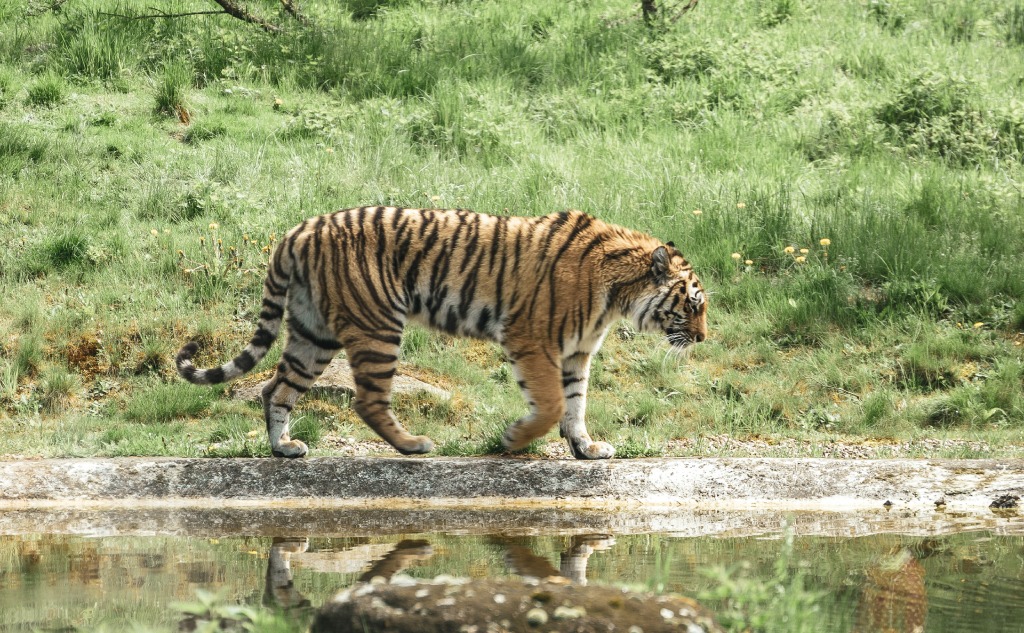Here’s who wins in a fight between a tiger and a crocodile:
In the water, if a crocodile surprise attack fails, the tiger has the edge.
On the land, crocodile’s chances for survival are almost impossible, and a tiger’s strength, speed, and ferocity make it easy to kill a crocodile.
Thus, the competition favors the great tiger, the strongest and largest big cat.
If you want to learn all about who would win in a fight between a tiger and a crocodile, then you’re in the right place.
Let’s jump right in!
Who Would Win in a Fight Between a Tiger and a Crocodile?
In the animal kingdom, survival is the ultimate objective.
An animal will eat whatever it can to survive, and tigers are no exception.
Although they prefer to eat medium and large-sized herbivores, desperate situations and a cruel fire in their belly can force them to eat big lizards, hippos, and even the hard, tough, and extremely dangerous crocodiles.
Crocodiles also have no mercy for big cats.
They are among the animals which can eat almost any other, from frogs to large herbivores, bears, and even big cats.
Almost all animals drinking from any water source in the wild have to be cautious.
The sneaky nature of the crocodile, coupled with its extremely powerful jaws, is something even the strongest animals can’t handle.
The crushing force of the jaw is enough to grind the neck of almost every animal.
The grasp of their jaw is so devastating and crushing that once an animal is trapped in its jaws, death becomes inevitable.
So, what would happen when the largest cat and the largest living reptile face each other?
Obviously, the result will be a tough and cruel fight.
But who is most likely to emerge victoriously?
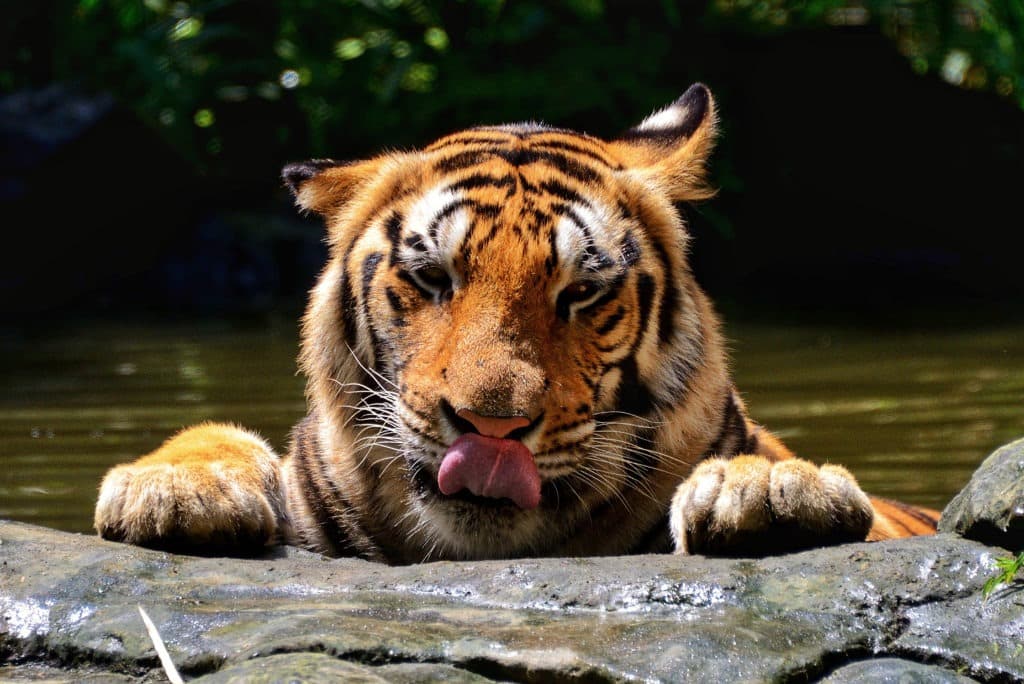
To answer this puzzle, let’s have a brief look into both of these sturdy and clever creatures.
Who Is the Tiger?
The wild is incomplete without the beautiful, stripy, strong, and clever tigers.
They are stronger and more fearsome than the fabled kings, the lions, and have a number of remarkable features which make them almost invincible creatures on land.
Subspecies of Tigers
These big majestic cats (Panthra tigris) have a number of regional subspecies, including Siberian tigers (Panthera tigris altaica), Bengal (or Indian) tigers (Panthera tigris tigris), Indo-Chinese tigers (Panthera tigris corbetti), etc.
Habitat of Tigers
Traditionally tigers thrive in the forests, swamps, savannahs, and grasslands over a vast geographical area ranging from eastern Turkey to the Sea of Japan and the Indian subcontinent, where the favored prey species of tigers were abundant.
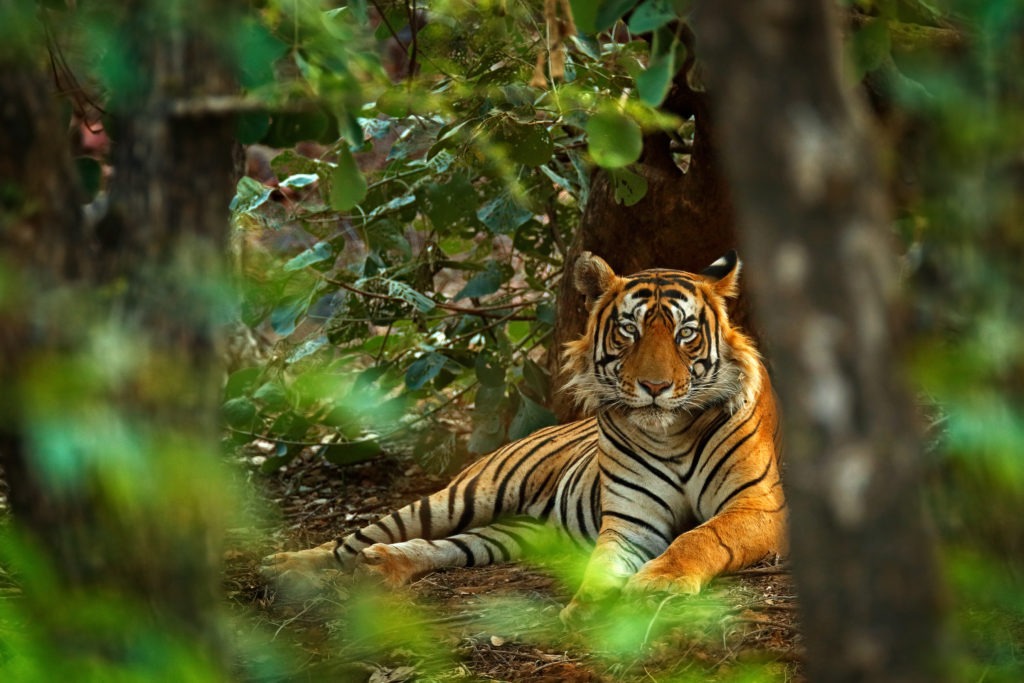
A tiger’s favorite prey species are deer and wild boar.
Unfortunately, 93% of historical tiger habitats are now squeezed due to increased human activities.
Physical Features of Tigers
Depending upon the subspecies, tigers have a huge range of size and weight, e.g., 100-261 kg (220-575 lbs) for males and 75-177 kg (165-390 lbs) for females.
Similarly, the Bengal tigers of northern India are up to 11 ft (3.4 m) in length, while the Sumatran tigers, native to Sumatra (Indonesia), are only up to 8 ft (2.4 m) long.
Tigers use their 3.3 ft (1 m) long tail to communicate signals.
For example, a loose hanging tail signifies relaxation, while a swiftly swinging tail indicates alertness and anger.
Stripes of Tigers
The long, smooth, insulating double hair coat of tigers bears a pattern of stripes that is an identification mark of tigers and is different for every tiger.
This striped hair coat not only helps them thermo-regulate but also works in camouflage.
Stripes range in color from yellow to reddish, while some mutant white tigers may have brown ones.
Social Behavior of Tigers
Unlike the lions that make prides, tigers are solitary and prefer to roam and hunt alone.
They are territorial and do need protection and nursing in childhood, which the females mostly carry out.
The males are normally dominant and larger, but sometimes the females can be fiercer when protecting their cubs.
However, the females are normally peaceful.
A study highlighted that tigers can recognize each other and sometimes may be willing to share prey.
Diet and Feeding Behaviors of Tigers
Tigers are exclusively carnivores, meaning they can only eat meat.
They can eat most animals in the wild ranging from small rabbits to crocodiles, grizzly bears, alligators, rhinoceros, and even elephants.
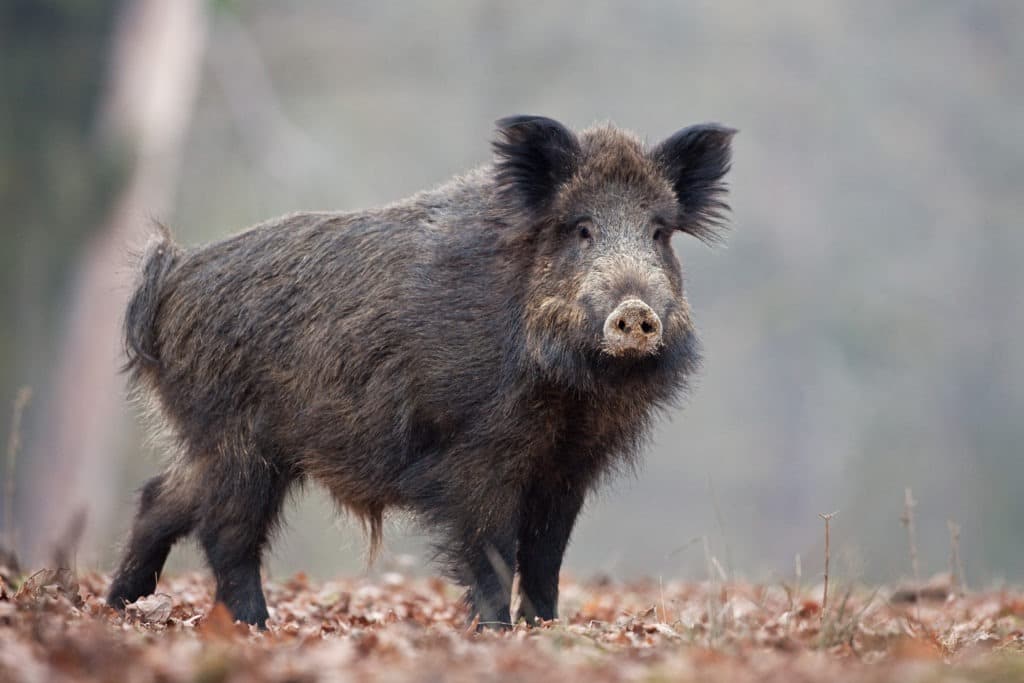
However, they show food preferences and tend to prefer wild boars and several species of deer.
They are nocturnal, meaning they hunt during the darkness and their excellent night vision is of great value.
Tigers do lack stamina, though.
Despite a maximum speed of 50 mph (80km/h), they struggle to chase down many of their prey animals.
Claw Structure of Tigers
One of the most fearsome features of these big cats is their claws.
There are 4 claws on each paw which are 4 in (10 cm) long and are strong enough to tear the flesh and rip it apart.
Each paw also has a specialized dewclaw in the forearms.
Jaw Structure and Bite Force of Tigers
The jaws of tigers are adorned with 30 strong teeth.
They have the strongest canine teeth of all the cats, which are 2.5-3 in (6-8 cm) in length.

The skull of a tiger is rounded and somewhat bulky.
The strong muscles in the skull enable them to exert a crushing biting force of 1050 psi which is significantly greater than a lion.
For comparison, a human punch generates around 120-150 psi.
Amphibious Assault Capability of Tigers
They are unexpectedly good swimmers, and unlike many other big cats, they don’t hate water.
They can make an amphibious assault and prey on fishes and even sturdy and hard crocodiles.
The tigers found in the Sundarbans are regularly observed swimming from one island to the other.
Who Is the Crocodile?
Animals in the wild are perhaps just as afraid of the powerful jaws of a crocodile as they are a pride of lions.
Crocodiles are tough, strong, and at the same time, extremely shrewd predators.

They are the largest surviving reptiles in the world.
Species of Crocodiles
“Crocodylidae” is a family of about 17 distinct species of crocodiles, each having its own geographical range and physical characteristics ranging from American crocodile (Crocodylus acutus) to Saltwater crocodile (Crocodylus porosus).
Habitat of Crocodiles
Each species of these reptiles is found in different geographical region.
As a general rule, crocodiles live in the tropical regions of the Americas, Asia, Africa, and Australia, mainly found in freshwater habitats.
Sometimes, they can also be noted in brackish water (salty but less salty than seawater).
The saltwater crocodiles are often found along the coastal regions of southeast Asia, the pacific islands, and Australia.
Physical Features of Crocodiles
Crocodiles are diverse in size ranging from just 6 ft (1.8 m) long African dwarf crocodiles to saltwater crocodiles of up to 20 ft (6 m) and 899-1151 lbs (408-522 kg).
Generally, females are lighter and smaller.
Crocodiles have large, elongated, and broad bodies, comparatively larger teeth, and strong muscular tails.
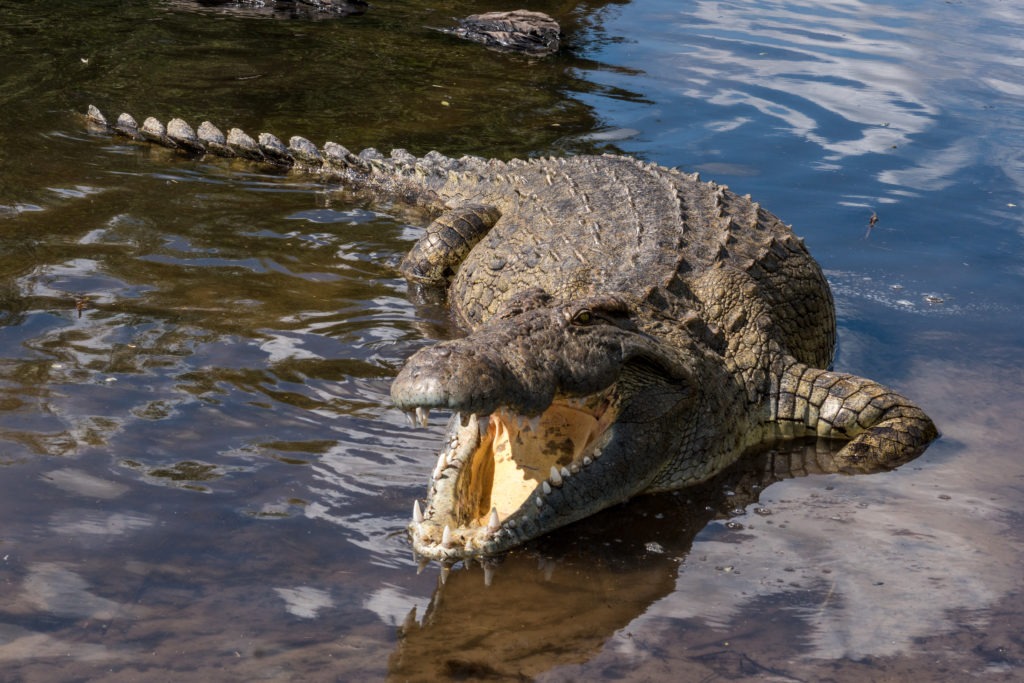
Their skin is tough, leathery, and is armored with bony scales. Their growth never stops, and length is also a measure of their age.
Social Behaviors of Crocodiles
Crocodiles are socially and mentally advanced and use many signals for communication like chirps, growls, hisses, grunts, and burps.
Their social behavior is quite sophisticated and advanced compared to other reptiles.
The males are extremely conscious of their territory. They defend and patrol their territories along the shoreline that could be up to 50 meters into the water.
Nile crocodiles are capable of diving for as much as 30 minutes when under threat.
They tend to establish a social hierarchy that helps them to coexist in crowded environments without fights.
According to experts, crocodiles can identify their neighbors from large distances and can identify who is inferior or superior.
Diet and Feeding Behaviors of Crocodiles
Crocodiles are opportunistic animals and can eat a wide array of animals.
Young hatchlings usually feed on insects, prawns, crabs, etc.
As they increase in body size, they increasingly prefer to eat vertebrates.
Fully mature saltwater crocodiles eat large animals, e.g., horses, buffalo, snakes, bears, and cattle.
Crocodiles are nocturnal in behavior and attack prey at night.
However, they will attack during the day because of their opportunistic nature, and most of their hunting activity takes place along the shores and river banks.
They usually adopt a “sit and wait” strategy but can also swim towards prey.
Jaw Structure and Bite Force of Crocodiles
Crocodiles have a solid V-shaped jaw.
Their jaws are adorned with strong and massive teeth varying from 60-110 depending upon the species.
During its entire lifespan, a crocodile can replace as many as 8000 teeth.
The structure of the jaw enables them to wield a massive bite force of as high as 5000 psi, far higher than African lions, Siberian/Bengal tigers, hyenas, and gorillas.
For comparison, the human bite force is around 150–200 psi.
All these features make them successful hunters.
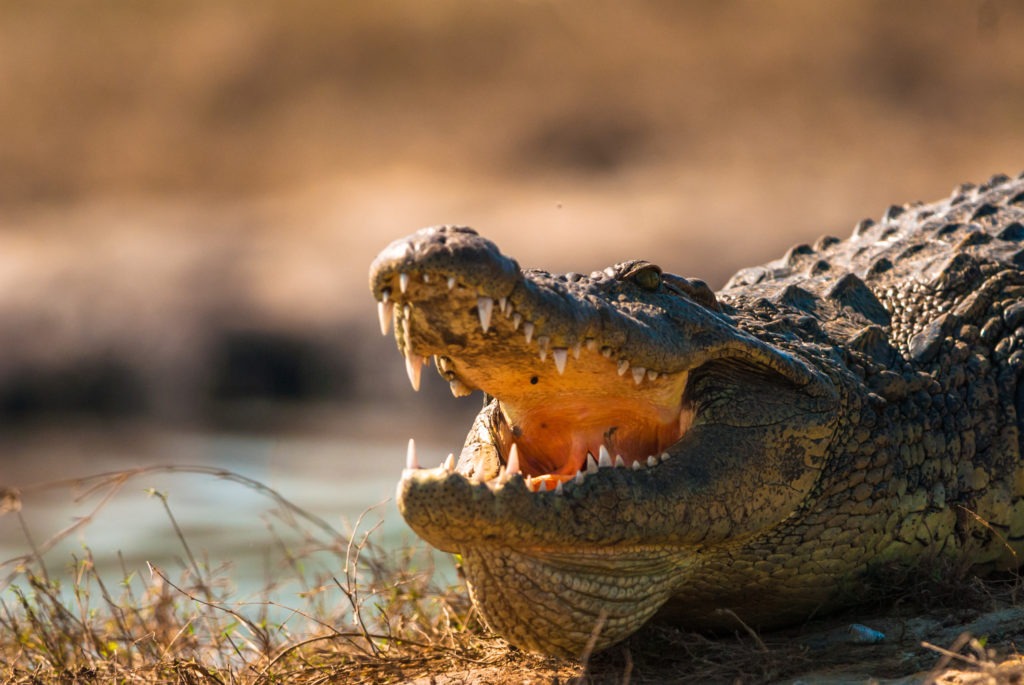
The grasp of their jaws is so strong that if an animal is entrapped in it, then escape becomes impossible.
Amphibious Assault Capability of Crocodiles
Crocodiles are highly notorious for their sudden surprise attacks.
They mostly attack along the shores when their prey is totally unaware of their approach.
These creatures can attack on the land as well.
Their presence has made the drinking activity of wild animals full of risk.
Do a Tiger and a Crocodile Fight Each Other?
The answer is obviously “yes.”
The wild animals are in a continuous state of war with each other.
Both tigers and crocodiles are merciless hunters and are very opportunistic.
Their fight is not only possible but highly probable because both try to hunt each other.
Although the crocodile is not their preferred food, large cats, including tigers, are known to attack and kill crocodiles when no easy prey is available.
Although it is a risky venture for the tigers, they muster courage and kill the big reptiles.
Likewise, the crocodile also has no respect for tigers and will grasp their necks whenever possible.
A tiger quenching its thirst on the shore of a water body can be attacked and eaten up by an opportunistic crocodile.
So their battle is a realistic scene in the wild.
What Are the Tiger’s Advantages?
The tiger has a number of advantages over the crocodile and can outfight it easily.
Some of the advantages are:
Speed and Agility
The main advantage the tiger enjoys over the hard crocodile is its speed, maneuverability, and resilience.

If the battle happens on land, the tiger has a decisive edge because the crocodile can’t match the maneuverability of the tiger.
Muscular and Flexible Body
The flexible and muscular body of a tiger can be highly helpful in any battle with unflexible crocodiles.
The tough and leathery skin of a crocodile hinders its mobility.
The tiger can easily dodge any attack by a crocodile on land and can deliver multiple attacks from different sides.
Bite force
Although a tiger’s bite force is only a fraction of the crocodile’s, it is not something to be ignored.
The soft parts of the crocodile’s belly are particularly vulnerable.
Duel Fighting Strategy
The tiger can use its jaws as well as its frontal paws for an attack.

If a crocodile is able to dodge its strong canines, it is still under constant threat by the razor-sharp claws of the tiger’s frontal paws.
The three-pronged attack by the claws and jaw is exceptionally horrible.
Intelligence
Tigers are also more intelligent than crocodiles.
In any fight with a crocodile, this added intelligence can be an additional advantage.
What Are the Crocodile’s Advantages?
The strengths of tigers are not enough to ensure an easy victory.
The crocodile also has several advantages over the tiger in any potential fight.
Strong jaws
Perhaps the biggest advantage the crocodile enjoys over the largest and strongest cat is its devastating and lethal jaws, producing a cataclysmic biting force.
Any mistake by a tiger can result in certain death.
The jaws of crocodiles are strong enough to dismantle the tiger easily.
The ancient Egyptians used to say, “If the teeth of a crocodile are shown, don’t think that it is smiling.”
Stealthy Attack
The second advantage the crocodile enjoys over the tiger is its sneaky attack.
An unaware tiger may not notice the approach of the reptile until all is over for him.
As the crocodiles can’t chase their prey, their only chance is to surprise it.
So, if the battle starts with a sneak attack by a crocodile, all the strength and sharpness of a tiger can’t help avoid a horrible fate.
Strong Tail
The tail of a crocodile is extremely tough and strong.
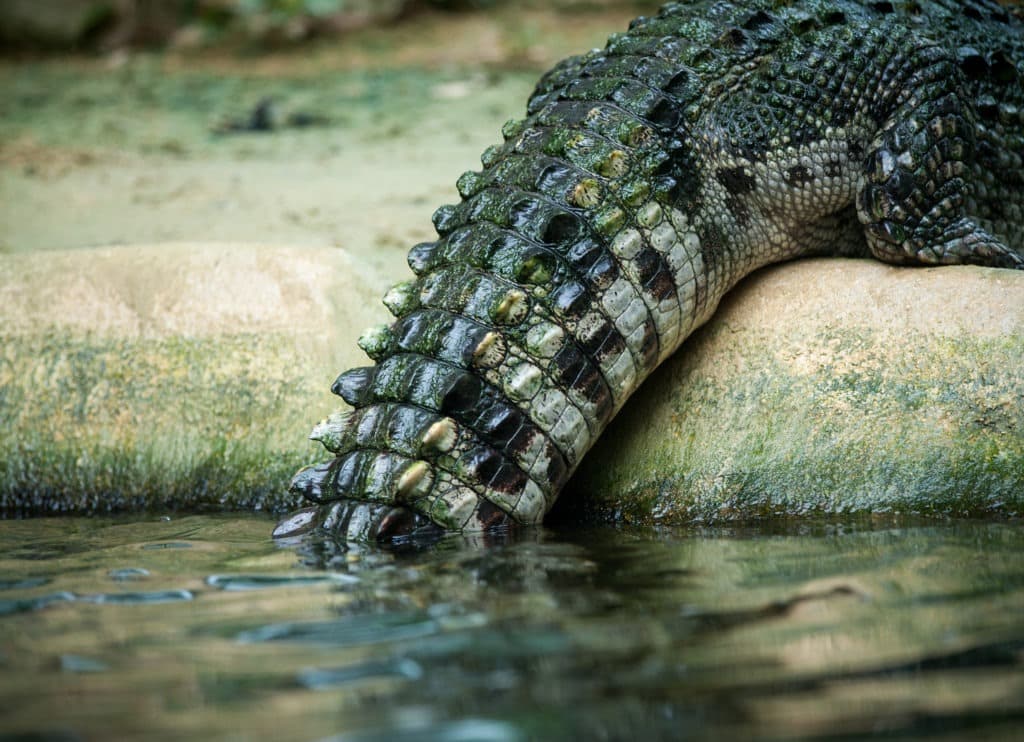
It can rotate the tail and avoid the bite of the tiger easily.
Hard and Tough Body
The body of a crocodile is extremely tough and hard.
The bony scales in their back act as “armor” and protect the inner organs in fights.
Some species of crocodiles are so heavily armored that the bite of a tiger can’t penetrate it.
Tiger vs. Crocodile: Who Wins the Fight?
Such battles are frequently observed in the wild.
A shrewd and cunning tiger notices a crocodile venturing on the land, or a crocodile observes a tiger drinking water on a shore after a successful hunt.
The result of both these situations is the same, an epic and ferocious battle.
The outcome of the battle will decide who will become the other’s dinner. The outcome largely depends on the nature of the battlefield.
Tiger vs. Crocodile: In the Water
If the battle occurs in water, the crocodile has an initial advantage. It can grasp the tiger in its jaws to kill it.
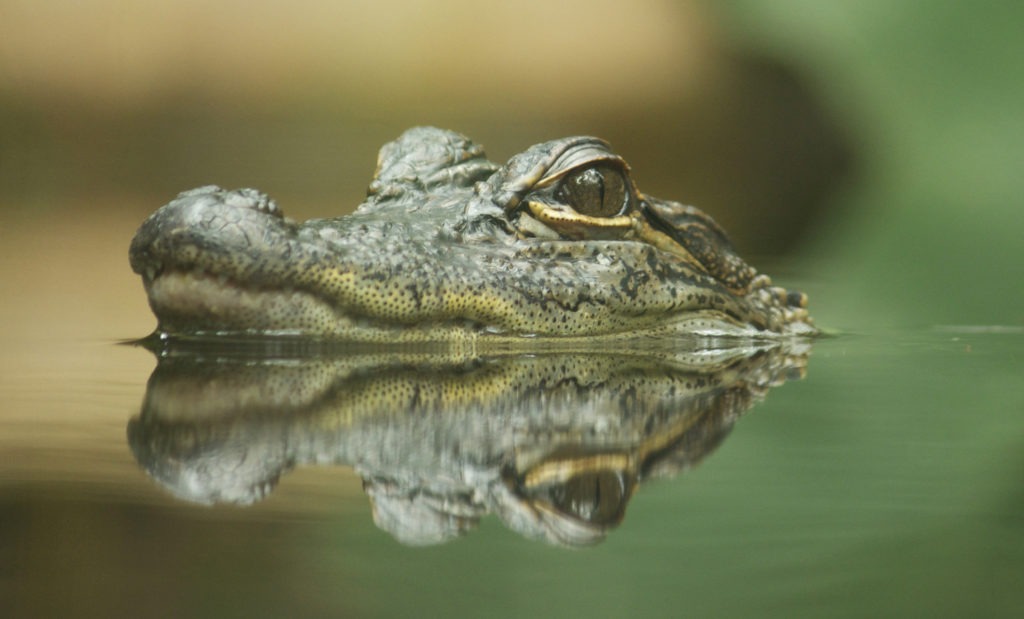
The battle is still far from being one-sided.
The tiger can counterattack with its sharp paws, and a successful retaliation can free the tiger from the jaws.
The tiger can now seize the initiative and kill the crocodile. Because tigers are also good swimmers, they can fight the crocodile on equal footing when the element of surprise has disappeared.
If the tiger is able to take hold of the croc’s skull in its jaws, it can pull the reptile towards the shore and kill it.
Hence, the outcome of the battle is solely dependent on the element of surprise by the crocodile.
Both have equal chances in the water, with the tiger having an edge if a surprise attack by the crocodile proves to be unsuccessful.
Tiger vs. Crocodile: On the Land
On land, the odds are almost impossible for the slow and inflexible crocodile.
The tiger can easily kill the crocodile with its speed, ferocity, and strength.
The clear winner here is the tiger.
You might have heard the story of Machali, a mother tigress who defeated and killed a strong and fully mature crocodile in front of spectators.
In the end, it can be concluded that both animals are strong and potent killers in their respective domains.
Both have equal chances of winning in water, while the tiger is a clear winner in the land.
Hence the competition is heavily in favor of the great tiger, the strongest and largest big cat.
